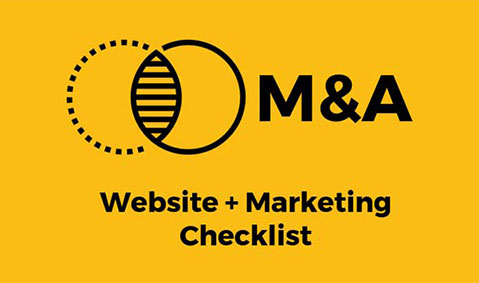

Blog & Insights
M&A Website and Marketing Checklist
August 31, 2022 | By Jessica Katz

Congratulations! Your merger or acquisition is complete.
Now you have a million things on your mind for what’s next. Maybe it was a small acquisition to increase your market share or to add a new product or service to your portfolio. And while you are working feverishly towards that new goal, somewhere along the way, it slipped that you should have a plan for all those “digital assets” that came with the new business. Or maybe you knew you should do something with them, but you weren’t quite sure what. How much are these digital assets worth, anyway?
During a merger or acquisition it is important to understand how to leverage the web-based systems/properties you have just acquired, and balance or combine them into your existing digital ecosystem. The decision to consolidate or maintain is an opportunity to assess the impact on future business. Think of it like a mini digital transformation.
As an example, how do you decide what to do with the acquired company’s website? Will you have more impact by maintaining that brand independently (and for how long), redirecting everything to your current company site, or rebuilding something new altogether?
Let’s run with the website example and say you decide to redirect the acquired website to your existing one. Did you know there are best practices for doing that the “right” way? And depending on your particular business, market share, and web activity on the acquired site, your timeline and steps will look different than someone else’s?
Taking Inventory
Before you dive into what you are going to do, and how, you need to take inventory of all of the newly acquired digital assets. Once you have a comprehensive list, make sure the right team members have administrative access. This will ensure your ability to execute your plan, on time, once it is established.
Your checklist may look something like this:
- New Company Digital Ecosystem:
- Website CMS
- Google Analytics or Adobe Analytics
- Google Tag Manager
- Google Ads or Microsoft Ads
- Google Search Console
- Google Business Profile (previously Google My Business)
- 3rd Party Marketing Systems (e.g. email marketing/marketing automation, SMS, review platforms, local listing platforms, etc.)
- Chat/customer support systems (web support, not internal chat like Slack, though that should be on your operations consolidation list)
- Call tracking systems
- Social Profiles and Social Ad Accounts
- CRM (this may be in your operations or sales consolidation list, but you can also consider it part of your marketing list if it’s not already accounted for)
- Additional items that may be covered under operations, but can be part of the marketing list as well:
- Hosting agreements
- All software licensing agreements
- Complete list and full access of domain names (and DNS records)
- Note who has what level of access in each system
- Assign your admin owner to each system
Once you have the master list of systems owned by the merged/acquired company, you will need to decide whether this will be maintained independently or consolidated into your existing systems.
We suggest building a simple chart to keep track of your progress. The following example only shows 3 systems, but should encompass your full list:
| Property/System | Maintain | Consolidate | Transition Plan |
|---|---|---|---|
| Google Analytics |  |
||
| Email Marketing |  |
||
| CRM |  |
Creating Your Transition Plan
Even if you are maintaining a system independently, it’s still a good idea to document the following for each property or system at minimum:
- Transition plan owner
- Identify admins
- Identify general system users
- Business case for maintaining independently
- Update payment method, if this is a paid for system
For each system or property that you are consolidating, you will have steps specific to that platform, but here is a general/high-level list to keep in mind:
- Transition plan owner
- Admins to add
- General system users to add
- Business case for consolidating the property
- Target date for EOL (end of life) of the system/property
- Note this may be impacted by system contracts that are in place
- Phased milestones to hit (example as follows, for our website consolidation)
- Banner on the old website announcing the acquisition and planned EOL
- Turn old website into a single landing page, directing users to the new site, reminding them of the planned EOL (old content still accessible by search)
- Full domain redirect to the new site, including a comprehensive URL redirect plan for any pages that had high SEO value on the old domain
- Archive old data as needed
- Cancel any payment plans, if this is a paid for system
Once you have completed the transition plan for each item, make sure to link the files back to your master table “Transition Plan” column, to keep everything organized on a single document.
This planning is detailed and can take some time, but it is important that it’s well thought out for the success of your business (and for the sanity of your teams working in all of these systems). When it comes to your mini digital transformation, GoldenComm has the team to walk you through it and get your newly acquired “digital things” in order. Give us a call or fill out the contact form.
